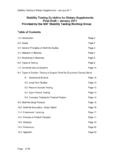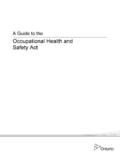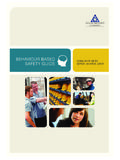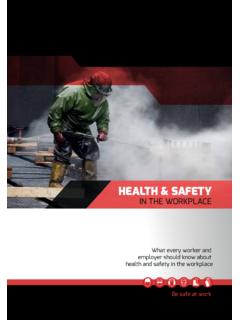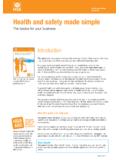Transcription of ISO 45001 OCCUPATIONAL HEALTH AND SAFETY …
1 ISO 45001 OCCUPATIONAL HEALTH and SAFETY management Systems Information guide Updated September 13, 2016 ISO 45001 Overview ISO 45001 is a new international standard for OCCUPATIONAL HEALTH and SAFETY (OH&S), providing a framework for managing the prevention of death, work-related injury and ill HEALTH , with the intended outcome of improving and providing a safe and healthy workplace for workers and persons under an organization s control. ISO 45001 , OCCUPATIONAL HEALTH and SAFETY management systems takes into account other international standards in this area, such as OHSAS 18001.
2 The standard is intended to help organizations, regardless of size or industry, in designing systems to proactively prevent injury and ill HEALTH . All of its requirements are designed to be integrated into an organization s management processes. The draft international standard (DIS) of ISO 45001 :2016 was published on February 12, 2016 and the ballot period ended May 12. With a final tally of 71 percent in favor to 29 percent against, the DIS ballot results fell short of the required votes, as no more than a quarter of the votes can be against for the standard to move on to the next stage of approval.
3 As a result, the development of ISO 45001 will now progress to a second DIS, beginning in January 2017 and pushing back the estimated publication date to December 2017. During the ISO/PC283 Project Committee meeting June 6-10 2016 in Toronto, Canada, the 3,000+ comments raised during the initial ballot period were discussed. The Project Committee meeting in October 2016 will review the remaining comments and finalize the second DIS, which will then be balloted again. Key Benefits of ISO 45001 ISO 45001 will implement the Annex SL process and structure, making integration of multiple ISO management system standards easier, such as ISO 9001, Quality management systems and ISO 14001, Environmental management systems.
4 It uses a simple plan-do-check-act (PDCA) model, which provides a framework for organizations to plan what they need to put in place in order to minimize the risk of harm. The measures should address concerns that can lead to long-term HEALTH issues and absence from work, as well as those that give rise to accidents. ISO 45001 enables an organization, through its OH&S management system, to integrate other aspects of HEALTH and SAFETY , such as worker wellness/wellbeing. The ISO 45001 standard calls for the organization's management and leadership to integrate responsibility for HEALTH and SAFETY issues as part of the organization's overall plan rather than shift responsibility to, for example, a SAFETY manager.
5 Why an ISO Standard? ISO 45001 Development Timeline (via ISO) Proposal Stage: Confirm new international standard subject area is needed. Preparatory Stage: Working group (WG) is set up to prepare the working draft (WD). Committee Stage: WD is shared with members of the parent committee. A committee draft (CD) is circulated to committee members for comment/reach consensus Enquiry Stage: The Draft International Standard (DIS) is circulated to all ISO members who get 3-months to vote and comment Approval Stage: The Final Draft International Standard (FDIS) is circulated to all ISO members for a 2-month vote.
6 This stage is skipped if the DIS is approved. Emerging Key Changes 1. Structure of International Standard 2. Organizational Context 3. Understanding Needs & Expectations of Interested Parties 4. Leadership 5. Worker Participation (Worker Representatives) 6. Hazard Identification/ Assessment of Risk 7. Planning 8. Need to prevent ill- HEALTH & injuries 9. Documented Information 10. Outsourcing, Procurement & Contractors 11. OH&S Performance Evaluation Key Change 1: Structure of International Standard - New Annex SL Structure Key Change 2: Organizational Context (Clause 4) Results of context review should be used to.
7 Understand & determine scope and issues (positive & negative) that can affect how organization manages OH&S management system Determine risk & opportunities Developing or enhancing OH&S Policy & set objectives High Level Understanding needs & expectations of workers & other interested parties (and differences for managerial & non-managerial workers) Issues include: conditions, characteristics or changing circumstances that can affect OH&S. Internal/external issues can result in risks/opportunities External Context Issues Cultural, political, economic, legal, natural surroundings, market competition New competitors, technologies, laws, new occupations Key drivers & trends in industry sector Relationships, perceptions & values of external interested parties Foreword Introduction Background Aim of OH&S management System Success Factors 1.
8 Scope 2. Normative References 3. Terms & Definitions 4. Context of the Organization 5. Leadership & Worker Participation 6. Planning 7. Support 8. Operation 9. Performance Evaluation 10. Improvement Annex A: Guidance on use of this International Standard Bibliography Alphabetical Index of Terms Emerging Key Changes Internal Context Issues: Organizational structure, roles, accountabilities; Capabilities; organizational culture Information systems, flows, decision making; Intro of new products and equipment; Standards, guidelines; contractual relationships.
9 Change in relation to working time requirements Key Change 3: Understanding Needs of Interested Parties (Clause 4) Needs & Expectations of both managerial & non-managerial workers & workers representatives (where they exist) Affect OH&S management system or which perceive themselves to be affected by OH&S system ( ) Worker & as appropriate workers representatives Legal & Regulatory authorizes Parent Organization Suppliers, co-contractors & subcontractors Workers organizations (trade unions) and employers organizations Owners, shareholders, clients, visitors, local community, neighbors, general public OCCUPATIONAL HEALTH & SAFETY organizations; OCCUPATIONAL SAFETY and HEALTH -care professionals ( , doctors, nurses) Note Needs & expectations from interested parties only become obligatory requirements for an organization if organization chooses to adopt them.
10 Interested Parties can include: Emerging Key Changes Key Change 4: Leadership (Clause 5) Leadership has been enhanced to ensure commitment & active support from top management Taking overall responsibility & accountability for protection of workers work-related HEALTH & SAFETY Ensuring OH&S policy & objectives established OH&S compatible with organizations strategic direction Integrating OH&S into organizational business process Allocating necessary resources OH&S (establish, implement, maintain & improve)


